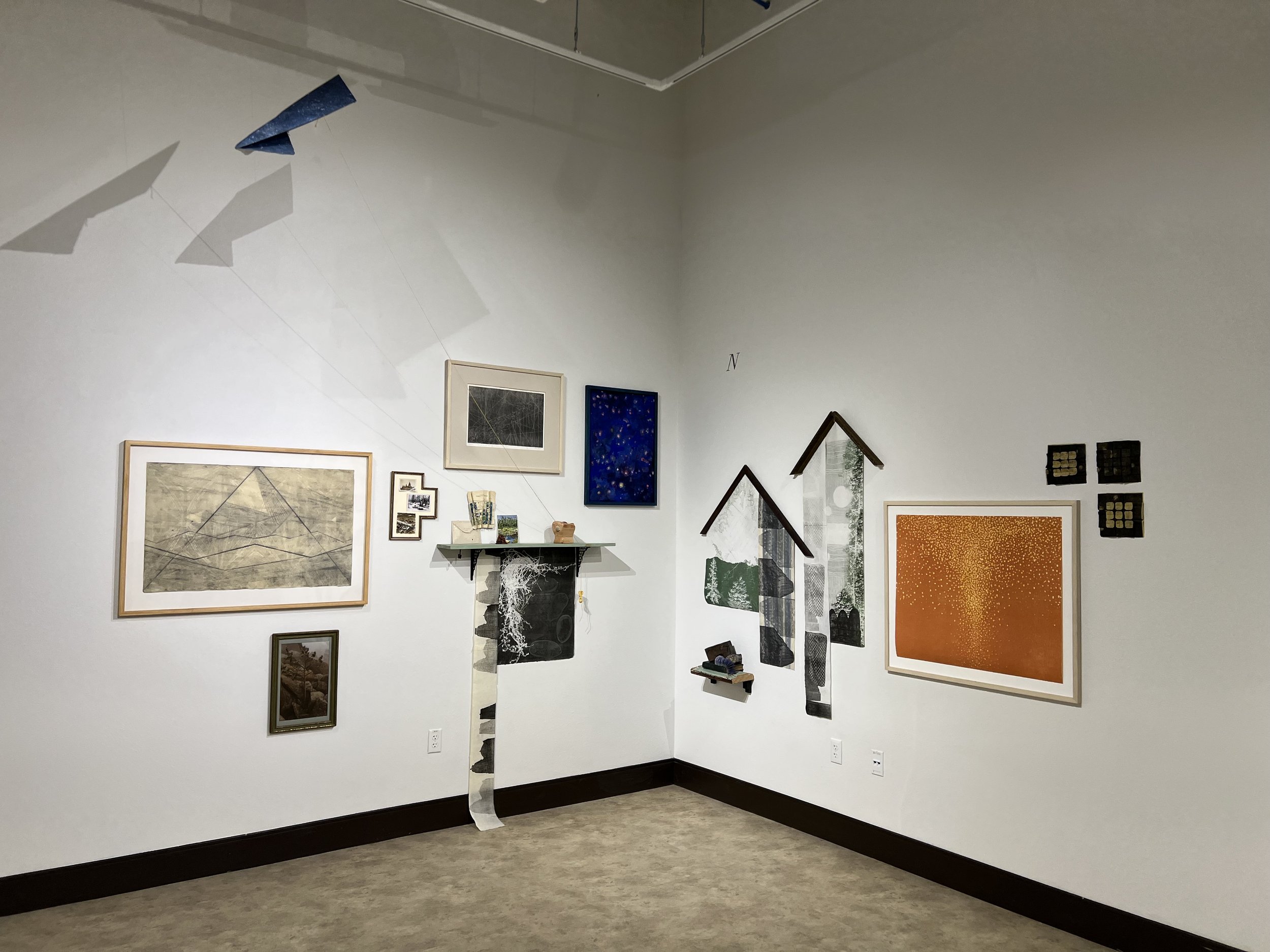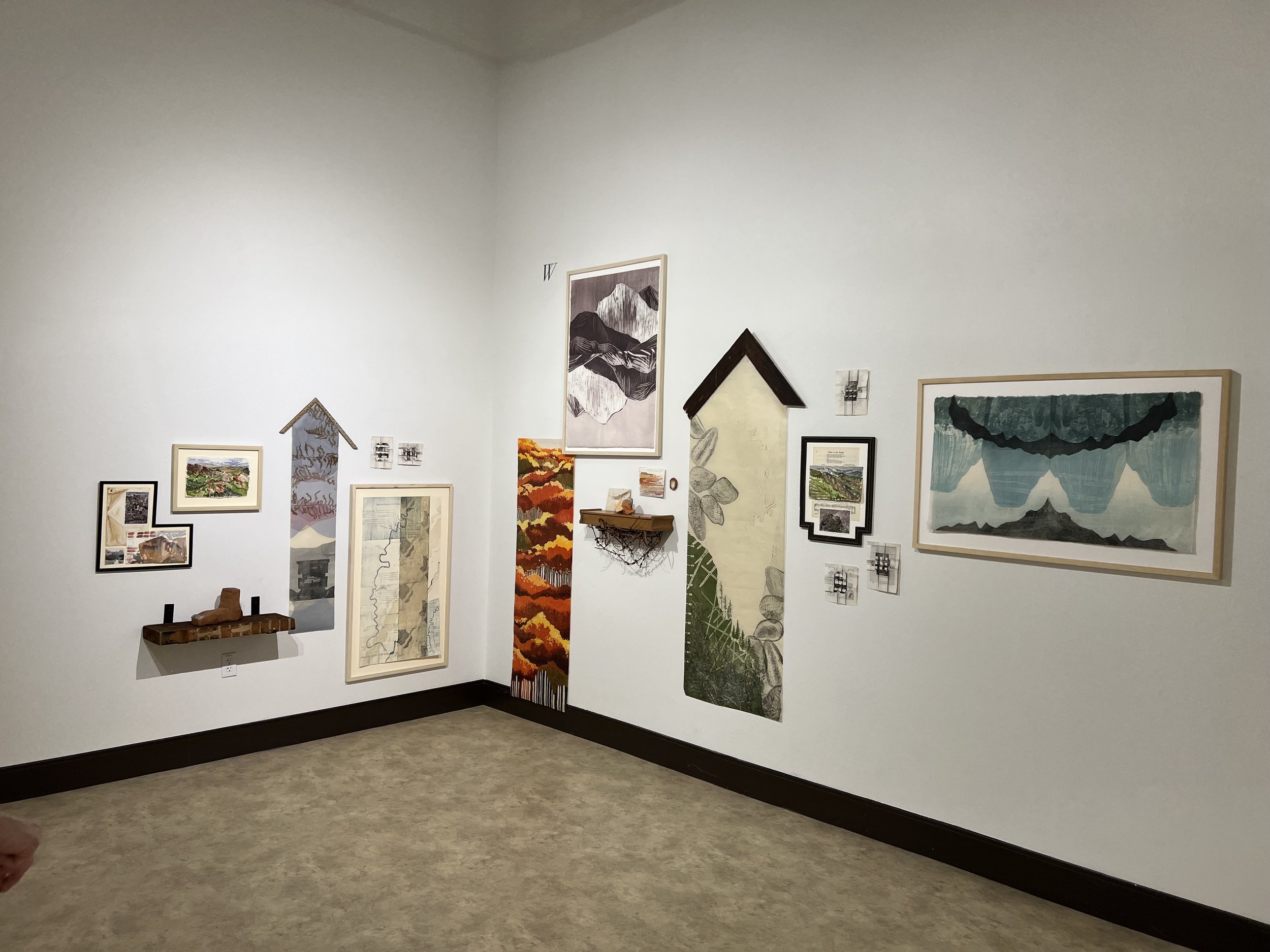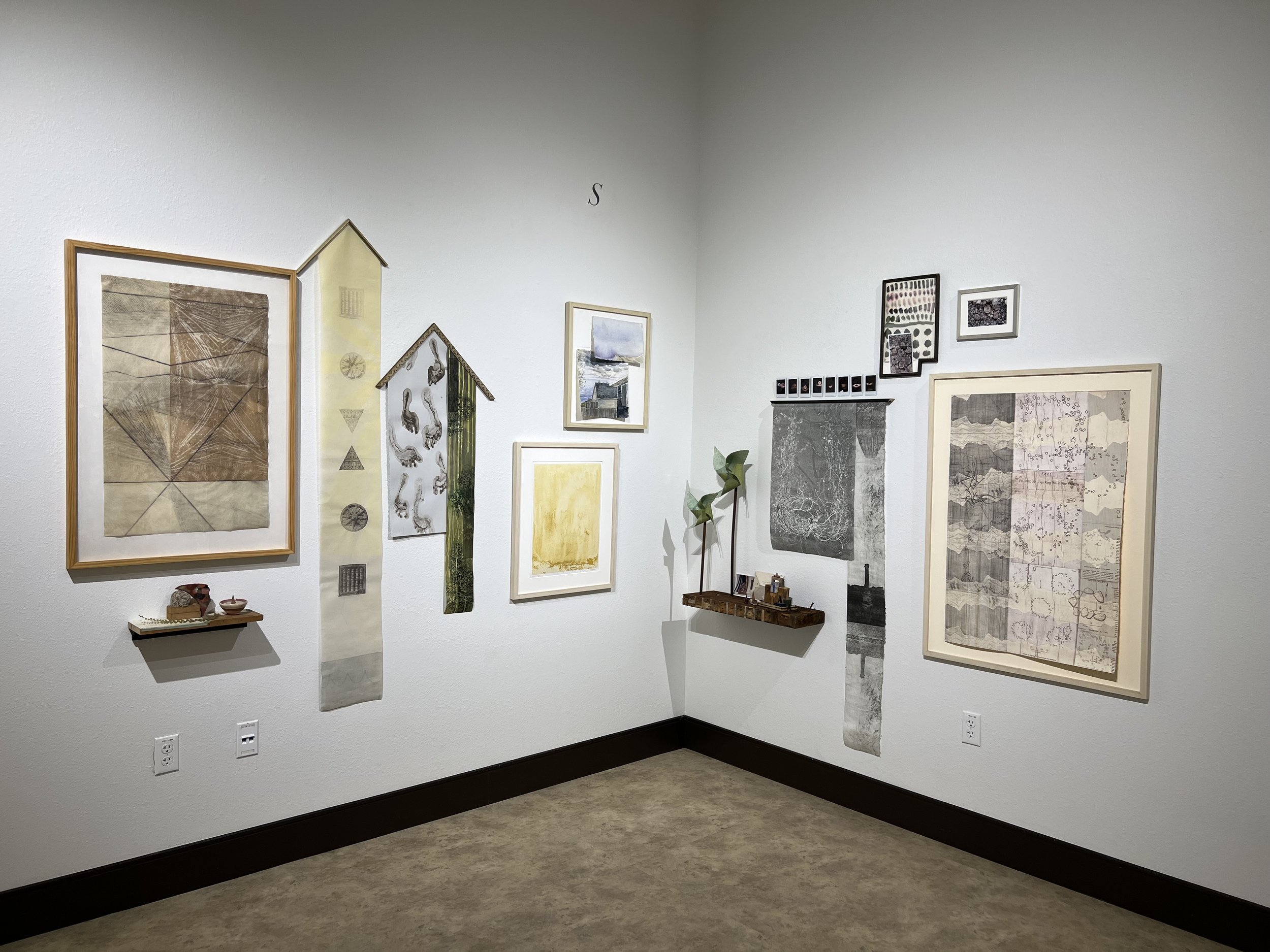East of West
Edward A. Whitney Gallery, Sheridan College, Sheridan, WY
February 6 – March 27, 2025
Artist talk in Kinnison Hall:
Thursday, Feb. 6, 2025 at 4:00 p.m.
Exhibition opening following at 5:00 p.m.
East of West : Exhibition Statement Summary
Using navigation as a foundation for the organization of the gallery, it is my personal associations of the cardinal directions that give context to each grouping. For example, North’s attributes align with my father, with truth, with grounding forces, navigation, and stellar inquiry. The visual connections of each grouping support the written narratives, which play back and forth as the clusters developed in tandem. Facts, anecdotes, quotes, poems, and analogies comprise both scientific and less definable, silkier sides of how I find myself in the world.
EAST
Manuports are rocks intentionally picked up and moved to new locations. Besides to build, what is it that drives us to pick up a rock? Do we find ease in its smoothness on our fingertips? Do we connect with something more ancient when we hold a fossil? Do we see ourselves in some way? Was this the beginning of the ready-made art object?
Rocks are portraits of the land and its occupants. Formed, moved, eroded, excavated, pressured, and changed over millennia, they connect lands in wonderous ways. Mazon Creek ferns trapped in iron encased nodules of Illinois coal extraction spoil piles tell of the plant-rich jungle of 300 million years ago, when flowers were yet to evolve. Over hundreds of years, this plant matter turned to carbon, leaving a coal seam in its wake. A single delicate leaf leaving such a lasting impression. More recently, a similar marshy occurrence referred to as the Western Interior Seaway led to a coal formation 40 million years ago in the Cretaceous period with robust coal seems in the high plains of Wyoming, making this state the most prolific coal-producing state in the nation.
I live now amongst the mound builders with preserved Cahokia mounds to the southwest and scattered effigy mounds to the north. Remains of established and migratory dwellings give evidence to human tools nearly 10,000 years ago, just a couple thousand years after the glacial recession. Glacial erratic boulders line the moraines where wind farms populate these higher plateaus across Illinois. Glacial deposits of nutrient rich, black soil give their nutrition year after year to some of the world's most prolific fields of soy and corn. Speckled into the patchwork are the acreages of organic farmers. In a 2024 farm tour, organic vegetable farmer Henry Brockman spoke of how responsible farmers give back to the soil, as we keep stripping it. The challenge of being a nurturer is how to return health to the source.
The Mackinaw River that winds westerly through Central Illinois past pockets of preserved lands has 30 known mussel varieties scattered throughout the sandy shallows. This keystone species of freshwater ecosystems largely does not move from its origin spot, meaning these bivalves reside in nearly the exact same place for 50, 60, or even 100 years. Some of these we pulled from the river, documenting what varieties were found. We recorded 17 varieties in 2023 with the white heelsplitter (Lasmigona complanata) being one of my favorites. Carefully placed back into the sand, some moved further in 2 hours than in the length of their entire life span.
One of the only mammals to survive the Ice Age, pronghorns don’t run this far east.
NORTH
An analog compass uses earth’s magnetic field to find north. Easily impacted by other metal objects or electronics, the magnetic north is unreliable. Depending on your location, the magnetic north may deviate as much as 18 degrees off True North in the continental U.S.
Much of my youth was spent in the soccer fields across the street from my childhood home. Brilliant Wyoming sunsets over the mountains oriented the west as we played past dusk. It was as if my centering point was outside of myself, resting on the peaks, like the jeweled bearing of a compass. What happens to this internal guide when the mountains are not in site? Where has my compass gone?
I am uprooted in the Midwest sending tendrils through my daughter to this rugged terrain. Ecologist, writer, and activist Terry Tempest Williams published letters she wrote to her father, thanking him for providing the “right foundation.” She referred to this silent but love-filled teaching as the Theology of the Mountains. Perhaps my daughter will send air roots up through me to tether herself to her grandfather and beyond, to this theology I was so gratefully provided.
Ode to Sanity #5 by Terry Tempest Williams
Clouds as thoughts / Thoughts as storms
A trickle of water / Displacing rock.
I am nothing but flesh, / Bones among stones,
Disappearance / Is the work of the wind.”
The Buddhist explanation of Dukkah is the First Noble Truth. Often translated as the state of suffering, Walpola Rahula describes Dukkah as “neither pessimistic nor optimistic. If anything, it is realistic... It refers to deeper ideas such as ‘imperfection,’ ‘impermanence,’ ‘emptiness,’ insubstantiality.’” We are not to ignore dukkha within us or around us, but to learn from it and detach from it. As Eve teaches us in the Old Testament (Genesis 3), it is Dukkha that shapes our perception of the world around us.
We are not the center of the universe. We are not unique. What good or harm you are capable of, I am also capable. Letting go of what separates us, what makes us special, is fundamental to seeing each other on level ground.
When you head up the Bighorn Mountains, you hike back in time.
WEST
My mother’s mother was born and raised in Kane, Wyoming after her parent’s parents homestead there in 1908. Shards of where Kane used to be are spread across land east of Lovell as the townspeople were displaced in 1964 by government officials to prepare for the building of Yellowtail Dam and the flooding of the Bighorn River. To this day, the water has never risen to the town of Kane.
The Bighorn River flows north from the basin ... cutting through Cretaceous and Tertiary rocks ... to the Paleozoic limestone anticline ... where it bisects the Bighorn Mountains ... from the independent uplifts of the Pryors ... converging into the great Yellowstone River running on and on some 60 miles away.
Tipi rings, buffalo jumps, sacred grounds, and wild horses give life to the Pryors. The stories of the Crow and Shoshone and their ancestral tribes are believed to date back 10,000 years and are still told here in each stone of the 140 rings documented. On the other side of the globe, stones give definition to Neolithic dwellings. In Illinois, glacial erratics are left in the wake of their recession. What remains now are all lithic rings, as the scraped blue-green erratics referred to as glacial till create circular borders to my pollinator garden.
Belemnite fossils, small bivalves that lived in the shallow sea, are scattered through the Jurassic formations of Amsden Creek. Referred to as the Devil’s toenails, what is it about mysterious natural findings that lead us to supernatural connotations? Devil’s Tower, the first national monument named in 1906, reveals a columnar formation so odd that it seems only myths can make sense of it; only a bear the size of Ursa Major could have clawed its way around this growing platform. Perhaps this is why ‘geology’ is named after Gaea, the Greek mythical daughter of chaos.
Matthew told of Jesus’s Sermon on the Mount where the Beatitudes have been retold for over 2000 years: “Blessed are those who mourn, for they will be comforted” (Matthew 5:4). The parallel from Luke is the Sermon on the Plain where Jesus descends the mountain to teach and heal the people while standing amongst them: “Blessed are you who weep now, for you shall laugh” (Luke 6:21).
In his book The Inner Reaches of Outer Space: Metaphor as Myth and as Religion, Joseph Campbell wrote about the yogic model of great transformations occurring in the region of the heart referred to as the anāhata. Curiously defined as “not hit,” it is interpreted as meaning “the Sound that is not made by any two things striking together.”
SOUTH
Perhaps I am mistaken, but I can align myself to South if I know the general direction. This feels significant given I cannot automatically distinguish my left from my right. In Tai chi, it is recommended to face South when practicing in the evening to take advantage of the earth’s magnetic field. I feel the pull, I feel the shift in energy, and I attempt to take in as much energy as I give out, a change from my role as a mother. My rational self calls this nonsense, but the rest of me knows it to be true.
“Think circles, everything is circular” my teacher Lilly Meiner reiterated as we moved through seated qigong (energy) movements. It is not coincidental that we use these movements to pull energy into the same place I associate with intuition, deep knowing, and life growing, right in the gut, a body center referred to as the Dan Tian.
What is a practice? The 13th century Buddhist Monk Shinran speaks of a practice as not something we do, but something we become. A practice allows us to become more of who we are. A practice needs community. It needs to be shared.
The process of printmaking is inherently filled with content. The repetition from a matrix is the source, the mother plate; the pressure of the press is transformative like geologic formations and the changing of time; a pulled mirrored image is both the same and opposite all at once; the positive comes from the negative, and the negative comes from the positive. These actions equate with other philosophic ideas related to ritual and a setting for discoveries.
Mountain Dwelling by Dōgen Zenji
The ancestral way comes from the west, I transmit east.
Polishing the moon, cultivating clouds, I long for the ancient wind.
How could red dusts from the mundane world fly up here?
Snowy night in the deep mountains in my grass hut.”
Unseen forces are revealed everyday in atmospheric systems. As the earth spins west to east, the westerly winds create mountain peaks of air as they collide with trade winds. High pressure systems push into low pressure systems to reach equilibrium, which, in turn, create winds alive around us.
Push and pull, yin and yang. Within each side there is always another push and pull to consider. To go left, we must also go right. To go East, we must also go West.
Research Citations 2019-2025
Scandinavian and Native North American Burials
Artelius, Tore, and Fredrik Svanberg. Dealing with the Dead : Archaeological Perspectives on Prehistoric Scandinavian Burial Ritual. Stockholm: National Heritage Board, 2005.
Henshall, A. S. (Audrey S.), and J. N. G. Ritchie. The Chambered Cairns of the Central
Highlands : an Inventory of the Structures and Their Contents. Edinburgh: Edinburgh University Press, 2001.
Ibn Faḍlān, Aḥmad et al. Ibn Fadlān and the Land of Darkness : Arab Travellers in the Far North. London: Penguin Books, 2012.
Fowler, Melvin L. (Melvin Leo). The Cahokia Atlas: a Historical Atlas of Cahokia Archaeology. Springfield, Ill: Illinois Historic Preservation Agency, 1989. Print.
Gill, Jerry H. Native American Worldviews : An Introduction. Humanity Books, 2002.
Kaul, Adam R., and Jonathan Skinner. Leisure and Death: an Anthropological Tour of Risk, Death, and Dying. Louisville, Colorado: University Press of Colorado, 2018.
Kyriakidis, Evangelos. The Archaeology of Ritual. Los Angeles: Cotsen Institute of Archaeology, University of California, Los Angeles, 2007.
Scarre, Christopher. Monuments and Landscape in Atlantic Europe : Perception and Society During the Neolithic and Early Bronze Age. London; Routledge, 2002.
Fossils
Nitecki, Matthew H. Mazon Creek Fossils : Papers Presented at the Mazon Creek Fossils Symposium Held in Ann Arbor, Michigan, May 1, 1978. New York: Academic Press, 1979. Print.
Buddhism, Hinduism, and Christianity
Brown, Brian. The Wisdom of the Hindus; the Wisdom of the Vedic Hymns, the Upanishads, the Mahabharata and Ramayana. New York: Brentano’s, 1921.
De Botton, Alain. Religion for Atheists : a Non-Believer’s Guide to the Uses of Religion. Camberwell, Vic: Hamish Hamilton, 2012.
Dōgen, and Kosho Uchiyama Roshi. Master Dogen’s Zazen Meditation Handbook : A Translation of Eihei Dogen’s Bendōwa : A Discourse on the Practice of Zazen. Translated by Shohaku Okamura and Taigen Daniel Leighton, Tuttle Publishing, 2022.
Grinshpon, Yohanan. Crisis and Knowledge : the Upanishadic Experience and Storytelling. New Delhi: Oxford University Press, 2003.
Joshi, R. C. Rebirth, an Analysis of the Hindu Philosophy of Rebirth. New Delhi: Metropolitan, 1988.
Kopf, Gereon. Beyond Personal Identity : Dōgen, Nishida, and a Phenomenology of No-Self. Curzon, 2001.
Kornfield, Jack, and Gil Fronsdal. Teachings of the Buddha. Rev. and enl. Ed., Shambhala, 1996.
Kuznetsova, Irina, Ganeri Jonardon and Ram-Prasad Chakravarthi. Hindu and Buddhist Ideas in Dialogue : Self and No-Self. Farnham: Ashgate Pub., 2012.
Lansing, John Stephen. The Balinese. Fort Worth, TX: Harcourt Brace College Publishers, 1995.
Lansing, John Stephen. The Three Worlds of Bali. New York, NY: Praeger, 1983.
The Holy Bible : New Century Version, Containing the Old and New Testaments. Word Bibles, 1991.
Walpola Rāhula. What the Buddha Taught. Translated by Walpola Rāhula, Rev. ed., Grove Press, 1974.
Taiji / Tai Chi
Fengos, Paul G. Taiji as Moving Meditation: Fundamental Principles and Practices. Singing Dragon, 2019.
Jwing-Ming, Dr. Yang. The International Foundation of Taijiquan: The Essence of Taiji Qigong. YMAA Publication Center, 1998.
Xingdong, Li. Basics of Taiji Quan. Foreign Languages Press, 1995.
Study of Ritual and Objects
Bell, Catherine M. Ritual Theory, Ritual Practice. Oxford University Press, 2009.
Bennett, Jane. Vibrant matter: a political ecology of things. Duke University Press, 2010.
Hartigan, Lynda Roscoe. Joseph Cornell : Shadowplay, Eterniday. New York, N.Y: Thames & Hudson, 2003.
Myths and the Self
Campbell, Joseph. The Inner Reaches of Outer Space : Metaphor as Myth and as Religion. 1st Perennial Library ed., Harper & Row, 1988.
Campbell, Joseph, and M. J. Abadie. The Mythic Image. Princeton, N.J: Princeton University Press, 1981.
De Botton, Alain. How Proust Can Change Your Life. 1st Vintage international ed. New York: Vintage International, 1998.
Orogeny, Rocky Mountain Formations, and Land Use
Johnson, M. R. W. (Michael Raymond Walter), and Simon L. Harley. Orogenesis : the Making of Mountains. Cambridge ;: Cambridge University Press, 2012. Print.
Parsons, Willard Hall. Field Guide, Middle Rockies and Yellowstone. Dubuque, Iowa: Kendall/Hunt Pub. Co., 1978. Print.
Harbaugh, John Warvelle. Stratigraphy and the Geologic Time Scale. 2d ed. Dubuque, Iowa: W.C. Brown Co., 1974. Print.
Husted, Wilfred M. Bighorn Canyon Archeology. 1969.
McPhee, John. Annals of the Former World. 1st pbk. ed. New York: Farrar, Straus and Giroux, 2000. Print.
McPhee, John. In Suspect Terrain. New York: Farrar, Straus, Giroux, 1983. Print.
National Park Service website last accessed 11/30/24: https://www.nps.gov/bica/learn/historyculture/yellowtail-dam.htm#:~:text=Ironically%2C%20the%20dam%20is%20named,land%20from%20the%20Crow%20tribe.
Sullivan, Walter. Landprints: on the Magnificent American Landscape. New York, N.Y: Times Books, 1984. Print.
Williams, Terry Tempest. Erosion : Essays of Undoing. First edition., Sarah Crichton Books/Farrar, Straus and Giroux, 2019.
Williams, Terry Tempest. The Hour of Land : A Personal Topography of America’s National Parks. First edition., Sarah Crichton Books/Farrar, Straus and Giroux, 2016.
Wyoming State Geological Survey website last accessed 11/30/24: https://main.wsgs.wyo.gov/energy/coal/coal-geology
Handmade History and Tutorials
Nylén, Anna-Maja. Swedish Handcraft. New York: Van Nostrand Reinhold, 1977.
Birrell, Verla Leone. The Textile Arts: a Handbook of Weaving, Braiding, Printing, and Other Textile Techniques. New York: Schocken Books, 1973. Print.
Pisello, Gina. Cut, Pleat, Twist. Video last accessed 11/26/24: https://www.youtube.com/watch?v=prtV0WC6vSo
Smith, Hervey Garrett. The Marlinspike Sailor. Tuckahoe, N.Y: J. De Graff, 1971. Print.
Poetry
Oliver, Mary. Blue Horses : Poems. New York: Penguin, 2014.
Rilke, Rainer, A. Maria Barrows and J. Macy, In Praise of Mortality: Selections from Rilke’s Duino Elegies and Sonnets to Orpheus. New York: Riverhead Books, 2005.
Weather, Global Discoveries, and Navigation
Aczel, Amir D. Pendulum: Léon Foucault and the Triumph of Science. First Atria books hardcover edition, Atria Books, 2003.
Adey, Peter. Air. Reaktion Books, 2014.
Ahrens, C. Donald. Meteorology Today : An Introduction to Weather, Climate, and the Environment. Tenth edition [international edition], Brooks/Cole, 2013.
Bachelard, Gaston. Air and Dreams : An Essay on the Imagination of Movement. Dallas Institute Publications, Dallas Institute of Humanities and Culture, 1988.
Dunn, Samuel. An Introduction to Latitude without Meridan Altitudes; and Longitude, at Sea; Having Contemporary Observations: And Nautical Formulas, Engraved on Copper Plates. Printed for the author, 1782.
Kals, W. S., et al. Land Navigation Handbook : The Sierra Club Guide to Map, Compass & GPS. 2nd ed. / completely updated, with New text by Clyde Soles., Sierra Club Books, 2005.
Malin, David, and Paul Murdin. Colours of the Stars. Cambridge University Press, 1984.
Musk, Leslie F. Weather Systems. Cambridge University Press, 1988.
Pinder, Eric. Tying down the Wind : Adventures in the Worst Weather on Earth. Jeremy P. Tarcher/Putnam, 2000.
Walker, Gabrielle. An Ocean of Air : Why the Wind Blows and Other Mysteries of the Atmosphere. 1st U.S. ed., Harcourt, 2007.





